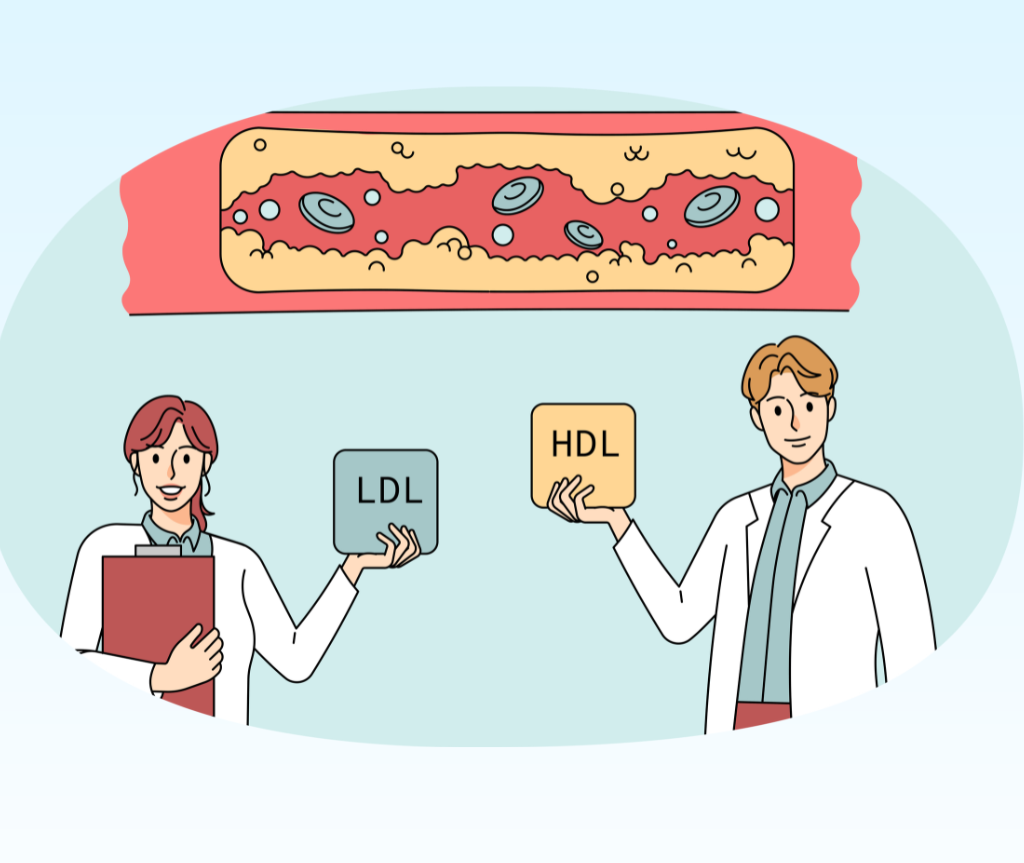Dyslipidaemia is a disorder of lipoproteins. It is a common condition that affects millions of people worldwide.
The essential lipids are LDL, HDL and triglycerides. The primary function of lipoproteins is to transport cholesterol and triglycerides from the liver to other parts of the body (such as the muscles and fat tissue).
LDL and triglycerides are considered unhealthy because they cause an increased risk of cardiovascular disease. On the other hand, HDL is good because it is heart-healthy.
Common forms of dyslipidaemia
Dyslipidaemia occurs when there is an imbalance between the amount of high-density lipoprotein (HDL) and low-density lipoprotein (LDL) cholesterol in your blood. Based on the levels of these lipoproteins, there can be,
- Hypercholesterolemia – increased cholesterol level
- Hypertriglyceridemia – increased TGs
- Mixed hyperlipidemias – increased both cholesterol and TGs
Causes for dyslipidaemia
Genetic factors, environmental or lifestyle-related factors, or a combination cause dyslipidaemia.
Autosomal dominant mutations cause LDL receptor abnormalities, which cause elevation of LDL levels.
Drinking too much alcohol increases your cholesterol levels by increasing the amount of low-density lipoprotein (LDL) in your blood.
Alcohol use is also associated with an increased risk of heart disease, stroke and high blood pressure.
Signs and symptoms of dyslipidaemia
Dyslipidaemia is generally asymptomatic and does not produce any noticeable symptoms per se. Still, there may be some non-specific symptoms, such as fatigue or depression.
Severe dyslipidaemia causes plaque formation and blocking of arteries. This results in cardiovascular diseases or peripheral vascular diseases. So, these vascular diseases can have features such as chest pain or leg pain with physical exertion.
How dyslipidaemia is diagnosed
Signs and symptoms are used as clues to diagnose medical conditions. Since there are few signs and symptoms of dyslipidaemia, blood tests are the most common way to diagnose the condition.
A lipid profile blood test is used for diagnosis, giving the status of LDL, TG, VLDL, HDL, total cholesterol level, TC and HDL ratio of the blood. Usually, you need to stay 12 hours fasting before this test—the lipid profile.
Treatment of dyslipidaemia
The treatment for dyslipidaemia depends on the severity, what caused it and associated medical conditions such as diabetes and cardiovascular diseases.
Treatment includes positive lifestyle changes such as eating a healthy diet and exercising regularly or with medication if necessary.
8 Tips to Improve Your Lipid Profile and Reduce High Cholesterol
Eating a healthy diet
Your doctor may advise a low-fat, high-fibre diet that includes plenty of vegetables, fruits, pulses and wholegrain foods (bread etc.).
You are advised to limit saturated fat in your diet. This means avoiding fatty cuts of meat (especially red meat), butter, lard, ghee, processed foods (sausage and bacon), cream, cake, biscuits and chocolate.
You also need to take more unsaturated fats (polyunsaturated and monounsaturated fats). Add more foods rich in omega-3 fats, such as fatty fish, soya, Brussels sprat, and flaxseeds.
Exercising regularly
Being physically active can help manage cholesterol. For example, aerobic exercises help to improve HDL cholesterol more than LDL and triglycerides. Losing weight will help lower your cholesterol levels if you’re overweight.
Lipid-lowering medications
Most of the time, medication is required to control high cholesterol. However, studies also show that combining healthy lifestyle changes and medications yields better results.
Several categories of cholesterol-reducing medications are available for treating dyslipidaemia. The selection of the drug category depends on the type of lipid abnormality. In addition, these drugs have different mechanisms of action.
- Statins – These drugs block the HMG-CoA-Reductase, an enzyme responsible for producing LDL cholesterol in the liver. The LDL in the blood is used for bile production, thus reducing LDL-cholesterol levels. The statins also have slight effects on reducing triglyceride and increasing HDL levels.
- Fibrates can decrease low-density lipoprotein (LDL) and increase high-density lipoprotein (HDL) levels. Still, their effects are generally less than what can be achieved with statins. Fibrates are currently mainly used for the treatment of hypertriglyceridemia. In addition, they are used in combination with statins to treat hypercholesterolemia.
- Bile acid sequestrants block cholesterol absorption. They also inhibit the reabsorption of bile acids. This causes a reduction of the bile acid pool and leads to increased bile acid synthesis using cholesterol. Thus reducing serum cholesterol levels.
- Niacin effectively lowers low-density lipoprotein (LDL) cholesterol and raises high-density lipoprotein (HDL) cholesterol.
- Omega-3 fatty acid derivatives are used as adjunctive therapy for severe hypertriglyceridemia in combination with a diet with or without other cholesterol-lowering medications. Omega-3 fatty acids reduce triglyceride levels.
Top 10 Omega-3 Foods Proven to Reduce Inflammation and Boost Heart Health
Suppose you are already taking medication for your high cholesterol. In that case, this may be continued or adjusted depending on how your body responds to the change in diet and exercise.
The Bottom Line
Dyslipidaemia is a risk factor for cardiovascular and peripheral vascular diseases.
There are multiple causes for the diseases. Genetic factors, unhealthy diet and lack of exercise are the main factors.
Treatment choice depends on how serious the underlying cause is and the associated medical conditions. Treatment choices are healthy lifestyle changes (diet and exercise) and medications. Commonly used medication is statins.



